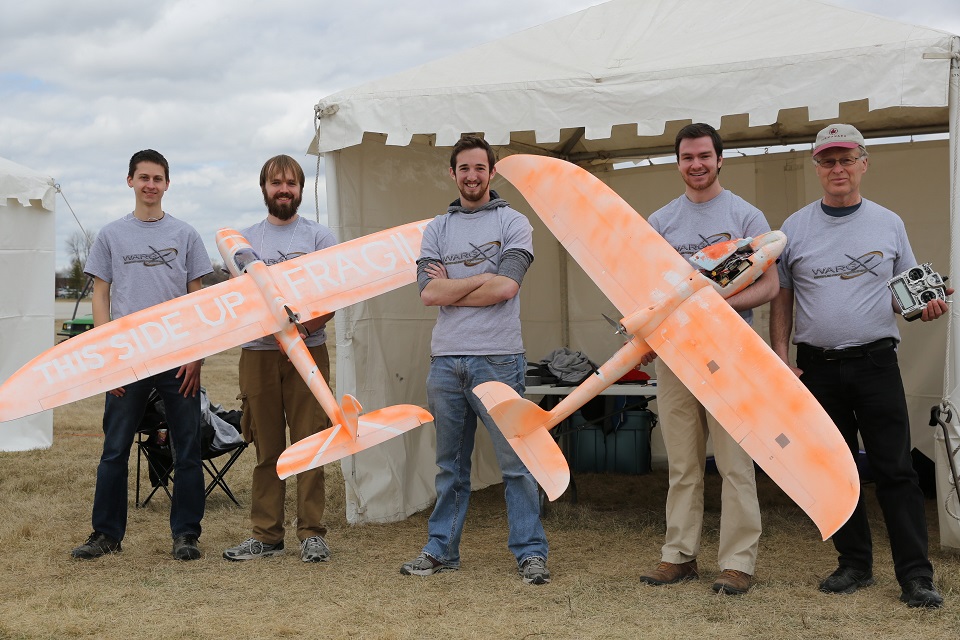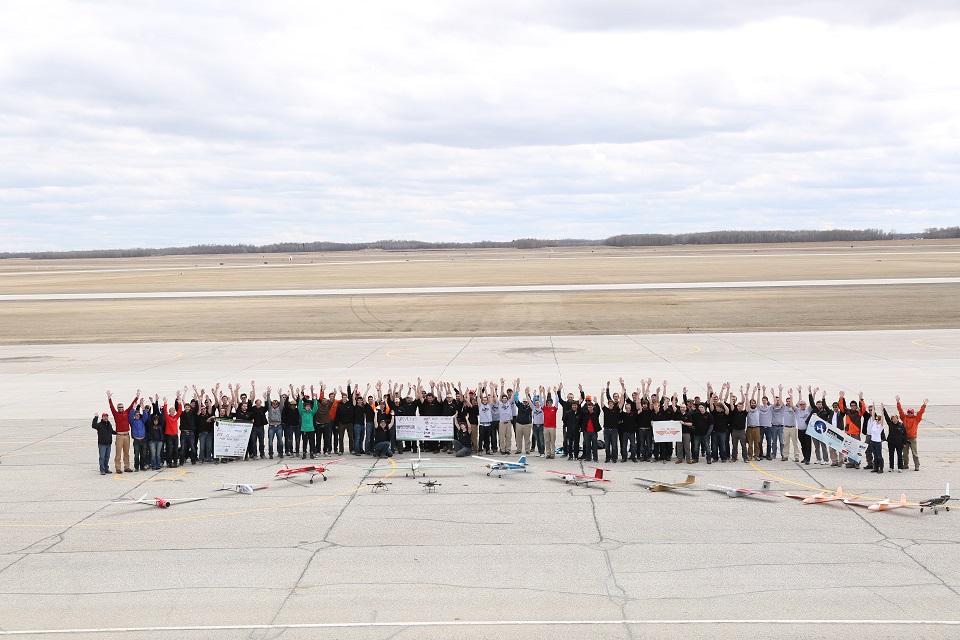
Gearing Up for the Next Competition!
The Waterloo Aerial Robotics Group is getting ready for our next competition - the Unmanned Systems Canada - Student UAV Competition! Since a majority of the current team leads now have experience at competition, we have big plans coming, and can't wait to get our new system going! We are busy recruiting new, and eager students to help us with projects for the team. We have projects for EVERY type of student out there, whether you're software, electrical, mechanical, systems, business, arts, we have something that will suit your interests! All we ask for in return is that you have the desire to learn, and the drive to help contribute to a growing team! We are TOTALLY revamping our system, and need YOUR help to make this project happen! Meetings during the Fall 2014 term normally take place Wednesday nights, and Saturday mornings / afternoons. If you're interested, come on out to E5 room 1101, or shoot us an email. We hope to see you there!
WARG Launches Student R/C Car Competition
In hopes of overcoming the constant struggle that Student Design Teams face in keeping new recruits interested, WARG has developed the R/C Car Competition. The competition is designed to be a fun learning tool to help fast track students in order to become actively contributing members with the team! The knowledge students gain while going through the competition is not just focused on WARG, but can be used towards many of Student Design Teams as well. The Waterloo Aerial Robotics Group's main goal is to provide students with learning opportunities, and to teach those who want to learn. We believe we have achieved this with the R/C Car Competition.... and the best part is.... you don't need to have any pre-requisite skills, only the desire to learn!
Unmanned Systems Canada Student UAS Competition 2014 - Post Competition Review
In 2013 the Waterloo Aerial Robotics Group started working on a fully autonomous aircraft for the purpose of entering the Unmanned Systems Canada Student UAS Competition 2014. The team drove approximately 27 hours over a 2 day time span to get to Southport Manitoba where the competition was held from May 2nd to 4th. There were 11 teams that competed in the competition from 10 Canadian universities, and we are proud to say that WARG exceeded our expectations, and we were able to hold our ground (or air) at the competition.
Prior to departure for Southport
The week before the competition was less than ideal for the team. An unfortunate 10 days prior to leaving for competition, the aircraft (Project S.P.I.K.E.) suffered a drastic crash landing that threw mud throughout the cockpit of the aircraft. The cockpit was home to all of the electronics, sensors, and camera, which meant that major system repairs, was required in order to fly the aircraft again. WARG doesn't give up that easily, and within the same afternoon, all of the electronics were cleaned and ready to go again. While in the air, it became apparent that the main and most crucial sensor of the aircraft, the IMU, seemed to be malfunctioning due to the muddy crash. A once fully tuned sensor, was now operating completely abnormally. The autopilot was unaware of the true orientation of the aircraft at any given time, making it impossible for the system to fly autonomously.
Luckily, WARG has some of the best sponsors in the business. A mere 7 days before competition departure, VectorNav (the creators of the IMU used by Project S.P.I.K.E.) became a true hero to the project. With an EXTRAODRINARY response time, VectorNav sent WARG a brand new shiny sensor to replace the malfunctioning IMU and get S.P.I.K.E. back in the air the following weekend. Without the response time, technical support team, and customer service representatives at VectorNav Technologies, WARG would not have had the opportunity to successfully compete at the Unmanned Systems Canada competition. The Waterloo Aerial Robotics Group members, faculty, and representatives of the University of Waterloo thank VectorNav for their support during a crucial time of need.
With a successful fully autonomous aircraft, built on a custom autopilot board with control code developed from scratch, WARG left for competition at 5am on April 30th, 2014. Project S.P.I.K.E. was now capable of flying complete paths that could be modified and updated during flight. Similar to a true surveillance drone, S.P.I.K.E. captured imagery of the terrain below and returned to its home coordinates without interaction from a human. Proud of the aircraft we created, the WARG team leads were anxious, nervous, excited, and prepared for what was waiting for them at the competition 2 days away.

Day 1 of Competition:
High winds blew across the runways in Southport on Day 1, and opened the competition with little promise of ideal flying conditions. Luckily for many of the teams, Day 1 was meant for inspections, presentations, and test flights, which meant that it was not mandatory or necessary to fly in the conditions. It became clear that WARG seemed to be the team with the greatest amount of confidence in their system. Project SPIKE approached the runway on this windy day, and began to soar into the sky. Following proposed paths with stable and controlled flight, SPIKE showed the competitors how it's done.
It also became apparent that WARG was the only team to be using a custom autopilot board. This point truly shows WARG's goal towards pursuing innovative solutions, and made us a stand out team at the competition.
Day 2 of Competition:
WARG was selected as the second team to fly at the competition, which meant a scheduled flight time for 7:30am on Saturday morning. Rising bright and early, it was clear that the wind conditions were once again less than ideal for flying, but this factor didn't scare us. SPIKE. successfully flew the competition area, but seemed to struggle against the strong winds whenever the aircraft turned in the same direction as the winds were blowing. This was not the fault of the autopilot, but instead a miscalculated path error by the team. After noticing this issue occurring, the team quickly acted to change the path so that the aircraft turned into the strong winds instead of with them. Due to this error, the images captured only seemed to cover half of the surveillance area.
As the day went on, it became more and more apparent that our miscalculated path would not damper our success. WARG was 1 of 3 teams to even fly on Day 2 due to the other teams' fear of the high winds, and on top of this, we were 1 of 2 teams to gather imagery of the surveillance area. As per the competition directors' words, WARG seemed to be the only team to submit a report that said anything besides "I'm Sorry."
Day 3 of Competition:
Again flying in the second slot of the day, WARG was up bright and early with the fortunate sight of low winds and clear skies. Making up for the error during the previous flight on Day 2, the team planned the path accordingly so that SPIKE would fly into the low winds. It became obvious that the winds would not be a factor against the controlled path following of the aircraft, so the path was modified on multiple instances during the flight so that the entirety of the surveillance area could be covered, and the key areas of interest had multiple sets of images. With a very successful flight, WARG proceeded to create a report with a lot more substance than the one created on Day 2, and were able to locate over 85% of the targets placed in the area.
Once again, as the day progressed, it became more and more apparent that WARG would be one of few teams to successfully fly the competition. Although more teams were able to get their aircraft up into the air on Day 3, very few seemed capable of flying the competition in its entirety. WARG became 1 of 4 teams that were effectively able to fly the competition in full, retrieving imagery of the entire surveillance area. Out of the 11 participating teams, the remaining 7 either: had technical issues during their flight, had technical issues on the ground and never got into the air, or simply crashed the aircraft mid-flight. The success rate of every teams' aircraft seemed to be relatively low, which is why I'm very proud of what WARG was able to achieve.

Final Results:
Unfortunately, WARG did not place in the top 3 for the competition, and the positions after the initial 3 were not mentioned. Our fault as a team became apparent during the report creation phase, where most of the marks for the competition were directed towards the ability of the team to process the images after the flight. WARG's main focus / goal during the development stage of Project S.P.I.K.E. was to create a fully autonomous aircraft that was able to follow a set path without failure given a list of GPS coordinates. I must say, that WARG was able to successfully meet and exceed this goal. Although the team was unable to perform where the marks counted (in the image processing sector), it was still apparent throughout the competition that WARG was a team to look out for. It is key to note that WARG did in fact have an image processing system going into the competition, that was completely capable of processing and stitching photos, as well as identifying the GPS coordinates of targets within the images. Unfortunately, this system began to malfunction as we arrived at the competition, and we were not able to fix the system in time.
Nonetheless, by being the only team to create a custom autopilot, and 1 of 4 teams to capture imagery of the entire surveillance area, I am excited to say that I am very proud of the WARG team members and what they were able to accomplish. They showed that although they were one of the least experienced teams at the competition, they were indefinitely one of the top teams to look out for.
I'm extremely proud of everybody who participated in the project, and I look forward to what WARG will be able to accomplish at next year's competition. I am positive that the Waterloo Aerial Robotics Group will continue to strive for innovative solutions to the UAV industry, and will show the industry what can truly be achieved.
Mitchell Hatfield - Team Lead - 2013
First General Meeting
The spring term has just begun and WARG, only returning from the Unmanned Systems Canada - Student UAV Competition last week is already eagerly looking towards next year's competition. WARG's success in Manitoba has the team looking to take more members and is planning on working with at least two aircraft over the spring term. There is a lot of work that needs to be done before we can go back to competition however. Projects that are going to be worked on this term may include but are not limited to:
- Aircraft Control
- Aircraft Design
- Tracking System
- Image Processing
- Ground Station
- Software
Questions, comments, concerns? Contact us at uw.warg@gmail.com